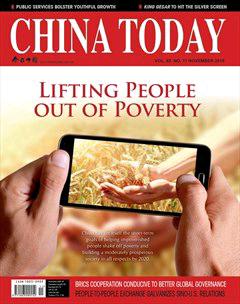Economy
Economy

China’s Record High Direct Investment in the U.S.
At around US $8 billion, China’s direct investment in the U.S. hit a record high in 2015, accounting for 5.5 percent of the country’s total outbound direct investment (ODI), according to the Report on Statistics of China’s Outbound FDI 2015, released at the end of September.
The manufacturing sector drew the most– around US $4 billion – accounting for half of the total Chinese investment (up 122.2 percent year-on-year), the report said. Rental and business services, which chalked up an investment of US $2.239 billion, came second, and scientific research and technology services, with US $1.228 billion, were third.
Throughout 2015, Chinese companies carried out 97 mergers and acquisitions in the U.S. worth US $13.05 billion.
With regards existing Chinese investment in the U.S., manufacturing held the largest share at 26.3 percent, with a total value of US $10.7 billion; the bulk of it in car making, ferrous metals smelting, pharmaceuticals, and transportation-related goods and equipment manufacturing industries, the report said.
China is now the world’s second-largest source of outbound investment, surpassed only by the United States. In 2015, the country’s total non-financial outbound direct investment also hit a historic high of US $118 billion, up 14.7 percent year-on-year.
Outbound Tours to Exceed 600 Million in Five Years
In the first half of 2016 China’s outbound tourists exceeded 59 million, and in the next five years Chinese holidaymakers are expected to take 600 million overseas tours, according to China National Tourism Administration (CNTA) data.
The steady rise in China’s outbound tourists over the past decade is attributed to relaxed visa policies and rising disposable incomes.
China ranked global No.1 in 2015 in the volume of outbound tours and the amount of cash Chinese travelers spent abroad, according to the CNTA. Over the past decade, China’s outbound tourism has expanded at an average 19 percent annually. The number of tours Chinese travelers took abroad soared from 12 million in 2001 to more than 107 million in 2014. The country now constitutes the largest market for outbound tourism.
Since 2012, China has been the biggest spender on international tourism, with an average annual contribution to global tourism revenue of more than 13 percent, according to World Tourism Organization (UNWTO) data.
Meanwhile, China’s booming domestic tourism market saw more than 4.1 billion journeys in 2015, generating tourism revenue in excess of RMB 4 trillion (about US $600 billion).

Rapid Expansion of Maritime Economy
Despite mounting downward pressure from both the world and China’s economy, the total production value of China’s maritime industry grew seven percent in 2015, according to the Report on Maritime Economy Development 2016, released at the end of September by the National Development and Reform Commission (NDRC) and the State Oceanic Administration (SOA).
The maritime economy generated RMB 6.47 trillion (about US $ 970 billion) in 2015, accounting for 9.4 percent of China’s total GDP, with growth slightly higher than that of the country’s GDP, the report said.
Maritime tourism grew 11.4 percent year-on-year, with a production value worth RMB 1.0874 trillion, making it a key growth engine for maritime output. The production value of the maritime bio-medicine industry, meanwhile, rose 16.3 percent year-on-year to RMB 30.2 billion.
More financial support has been made available and foreign cooperation deepened in efforts to promote the maritime economy, according to deputy head of the SOA, Fang Jianmeng. In 2015, Qingdao and Yantai saw the establishment of international marine property trading centers that offer information and intermediary services regarding the right to use sea islets and develop marine mineral resources. The marine economy thus plays an expanding role in China’s economic growth.
Zhang Zhanhai, head of the SOA Strategic Planning and Economy Department, said that China is accelerating structural adjustments to its maritime industry by taking advantage of the Internet and big data technologies. The development of the maritime economy is also expected to promote industrial upgrading and transformation in coastal areas.
Asset Allocation Restrictions on Foreign Investors Scrapped
China’s securities regulator announced at the end of September the removal of asset allocation restrictions on qualified foreign investors to allow them greater investment freedom, according to Xinhua.
In theory, neither the allocation mix for investors under the Qualified Foreign Institutional Investors (QFII) nor the RMB-denominated Qualified Foreign Institutional Investors (RQFII) programs will be restricted, the spokesperson for China’s Securities Regulatory Commission, Deng Ge, said.
China’s RMB has been convertible for trade purposes under the current account, but the capital account is still largely controlled by the state, due to concerns that sudden capital in- and outflows would harm the national economy. To gradually open the capital market, the government introduced the QFII program in 2003 and in 2011, the RQFII program. Each has played a positive role in introducing foreign capital, optimizing the business structure of investors, improving the management of listed companies, and promoting the stable development of the capital market.
China formerly required overseas investors to invest at least 50 percent of their assets in stocks, with a cash ratio of no more than 20 percent. However, in recent years overseas investors have called for more flexible asset allocation.
Official data shows that, at the end of August, 300 overseas institutions had received quotas collectively totaling US $81.5 billion under the QFII program, while 210 overseas institutions had received a quota of US $76.6 billion under the RQFII program.


